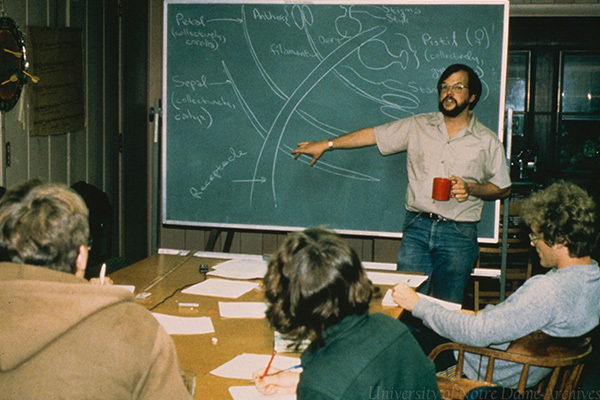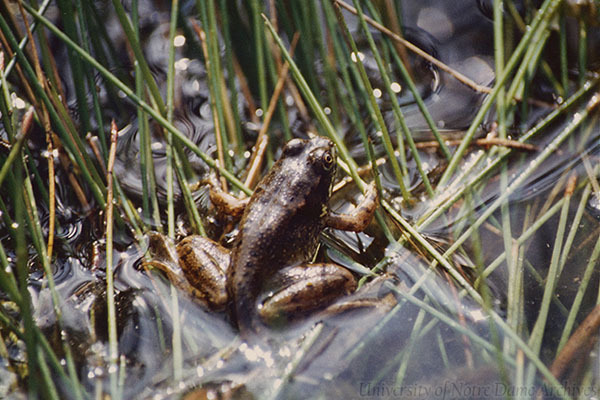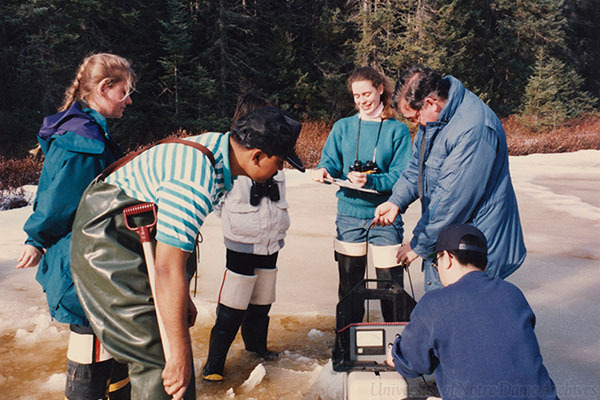History
History

Martin J. Gillen, attorney and financial advisor, donated the Land O’Lakes property, which spans parts of Michigan and Wisconsin, to the University of Notre Dame in the 1930s. His future vision of a religious and educational sanctuary drove him to amass 7,500 acres containing 30 lakes, several bogs, and secluded woods. Gillen, an avid outdoorsman and biology enthusiast, encouraged scientific research on the property and scientists from the University of Wisconsin-Madison and other institutions accepted the invitation.
Edward Birge, former President emeritus of Biology at the UW-Madison, conducted research on 600 lakes in Wisconsin, seven of which were located on the property. At a symposium of biology on September 5, 1940 Gillen said that Birge addressed the crowd and stated “that he believed the properties of the University of Notre Dame of forest land, cut-over, and new growth with drainage and seepage lakes, swamps, pot-hopes, and running river, all available by road—are the finest and most unique piece of scientific property in the north, for experimental purposes in these three fields [biology, botany, & zoology].” He hoped that some day these properties would be the center of summer experimentation by the scientists of the nation.
In 1951, Professor Arthur Hasler of the University of Wisconsin led the first whole-lake ecosystem study of its kind on the Notre Dame property. Hasler divided a lake in half using an earthen dike and named the new lakes Peter and Paul. He removed the native fish and replaced them with trout. Lime was added to Peter while Paul remained the control lake. As a result of the experiment, trout ate zooplankton more effectively causing Peter Lake plankton to develop differences from Paul Lake plankton.
In 1957, Fr. Theodore M. Hesburgh, president of the University of Notre dame from 1952 - 1987, was appointed by President Dwight D. Eisenhower to the Civil Rights Commission. While conducting a series of hearings that found African Americans were being denied their right to vote, a federal judge deemed the Commission unconstitutional and an upcoming hearing in Louisiana was canceled. This decision was eventually overturned, but Fr. Hesburgh suggested moving the Commission to UNDERC. During their time at UNDERC, the Commission crafted and voted upon the 12 recommendations presented to Congress that formed the foundation of the 1964 Omnibus Civil Rights Act.
In 1967, the Land O' Lakes property again played a role as an important convening space. Lead by Fr. Hesburgh, a group of educators met to discuss "What is the nature and role of the contemporary Catholic University?". The result was a document entitled "The Idea of the Catholic University", which is frequently referred to as "The Land O' Lakes Statement".

The first scientist from the University of Notre Dame to conduct research on the property was Fr. Peter E. Herbert. During his visits he cataloged botanical specimens. During the 1960s, the Notre Dame biology department advocated for a research facility to be built on the property. After a committee was formed and visits to the property were made, in 1968 the University issued a press release stating that the property would become a “conference and recreation site” and a “research area.”
Professor George Craig, entomologist and vector biologist, started bringing students to the property in 1976. At that time, students lived in trailers and classes met in the boathouse. Fr. Theodore Hesburgh wanted to further the University’s commitment to research and persuaded friends of Professor Craig, Bernard J. “Jerry” Hank ‘51 and his wife, Joyce, to get involved in the property. They fell in love with the place and their contributions led to several living quarters and a laboratory.
In 1978, Carl von Ende was the first Notre Dame scientist to publish a scientific paper from UNDERC. More than 350 scientific papers, book chapters, theses, and dissertations have come from work done at UNDERC.

The Northern Highlands Experimental Ecological Reserve was formed in 1980 between UNDERC and the nearby Trout Lake Station started by Birge of the UW-Madison. Located also nearby is the Ottawa National Forest and the North Central Forest Experimentation Station, and in 1992, UNDERC signed a “Memorandum of Understanding” with these two entities for conjoined future research and habitat management and protection activities.
In 2008, UNDERC became the core terrestrial and aquatic site for the Great Lakes region in the National Ecological Observatory Network (NEON). NEON conducts extensive ecological monitoring at UNDERC ranging from field data collection to remote sensing to passive data collection via a canopy tower. This data infrastructure provided by NEON and NEON-UNDERC cooperation makes UNDERC a premier destination for terrestrial and aquatic research in the northwoods.
Current research foci at UNDERC include long-term whole-lake ecosystem manipulations, the installation of a new large scale forest dynamics plot in collaboration with the Smithsonian's ForestGeo network, long-term investigations into small mammal behavior and population dynamics, the physiological, functional genomic and hyperspectral responses of trees to drought and functional genomic and behavioral studies of fish populations.